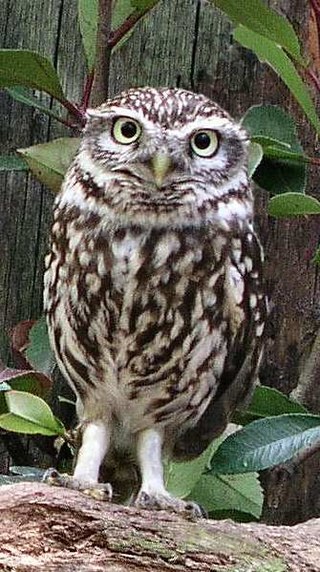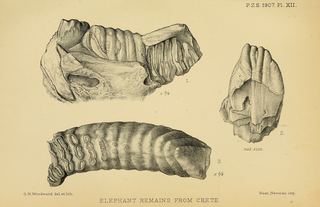
Dwarf elephants are prehistoric members of the order Proboscidea which, through the process of allopatric speciation on islands, evolved much smaller body sizes in comparison with their immediate ancestors. Dwarf elephants are an example of insular dwarfism, the phenomenon whereby large terrestrial vertebrates that colonize islands evolve dwarf forms, a phenomenon attributed to adaptation to resource-poor environments and lack of predation and competition.
The Cypriot mouse is a species of mouse endemic to Cyprus. Its primary habitat seems to be the vineyards and fields of the Troödos Mountains region.

Athene is a genus of owls, containing nine living species, depending on classification. These birds are small, with brown and white speckles, yellow eyes, and white eyebrows. This genus is found on all continents except for Australia, Antarctica, and Sub-Saharan Africa. An evolutionary radiation of 4 species is also present in the Solomon Islands.

The Sardinian dhole is an extinct insular canid which was endemic to what is now the Mediterranean islands of Sardinia and Corsica during the Middle-Late Pleistocene. It went extinct at the end of the Pleistocene around the time of human settlement of the islands.

Candiacervus is an extinct genus of deer native to Pleistocene Crete. Due to a lack of other herbivores, the genus underwent an adaptive radiation, filling niches occupied by other taxa on the mainland. Due to the small size of Crete, some species underwent insular dwarfism, the smallest species, C. ropalophorus, stood about 40 centimetres (16 in) at the shoulders when fully grown, while other species were relatively large and comparable in size to mainland deer species. Some species are noted for their peculiar, elongate club-shaped antlers, though other species have more normal antlers.

The Cypriot pygmy hippopotamus is an extinct species of dwarf hippopotamus that inhabited the island of Cyprus from the Pleistocene until the early Holocene.

Palaeoloxodon cypriotes is an extinct species of dwarf elephant that inhabited the island of Cyprus during the Late Pleistocene. The species became extinct around 12,000 years ago, around the time humans first colonised Cyprus.

The Cretan owl is an extinct species of owl from the Pleistocene of the island of Crete, in the eastern Mediterranean. It was first named by P.D.M. Weesie in a paper in 1982. In life, it would have been at least 60 cm tall, considerably larger than the 22 cm long little owl and appears to have been terrestrially adapted, with relatively short wings and long legs. Its primary prey was likely the endemic mouse species Mus minotaurus, as evidenced by the numerous owl pellets containing it recovered from the caves from which the bones of A. cretensis were found.
Hippopotamus creutzburgi, the Cretan dwarf hippopotamus, is an extinct species of hippopotamus from the island of Crete. It lived on the island from the Early Pleistocene to early Middle Pleistocene, and probably descended from Hippopotamus antiquus. It was considerably smaller than H. antiquus, weighing approximately 400 kilograms (880 lb). It was one of only two large herbivores on the island during its existence, alongside the dwarf mammoth Mammuthus creticus, with large predators being absent, the only other species of mammal present on the island being the giant rat Kritimys. It is known from abundant remains collected from the Katharo basin in the eastern uplands of Crete, approximately 1,100–1,200 metres (3,600–3,900 ft) above sea level, as well as much rarer remains found in coastal caves. Analysis of its limbs suggests that it was more adapted to terrestrial locomotion than living hippopotamus, primarily walking on its hooves rather than its footpads as in living hippopotamus, and capable of traversing the rugged terrain of Crete. Analysis of its teeth suggests that it had a grazing diet, similar to modern Hippopotamus amphibius. The previous suggestion that the species can be divided into two subspecies is not supported by modern research.

The wildlife of Cyprus includes its flora and fauna and their natural habitats. Cyprus has a rich flora and a diverse fauna albeit with relatively few mammals. Like most modern countries, the natural habitats in Cyprus have been steadily disappearing, currently retaining only 20% of its original habitat due to rapid urbanization, usage of forests for commercial purposes, tourism and various other reasons. One of the features of Cyprus' habitats is the wild and sharp differences in elevations and habitats on the island as well as climate, all of which supply a diverse habitat for an array of fauna and flora. Terra Cypria was established as a trust in 1992 to conserve the Cypriot environment and its biodiversity.

Hypnomys, otherwise known as Balearic giant dormice, is an extinct genus of dormouse (Gliridae) in the subfamily Leithiinae. Its species are considered examples of insular gigantism. They were endemic to the Balearic Islands in the western Mediterranean from the Early Pliocene until their extinction around 4,000 years ago. They first appeared in the fossil record on Mallorca during the Early Pliocene, presumably due to the Messinian salinity crisis causing a connection with mainland Europe. They later spread to Menorca, and a possible molar is also known from Ibiza. Hypnomys became extinct during the Holocene after human arrival on the Balearics. They were one of only three native land mammals to the islands at the time of human arrival, alongside the shrew Nesiotites and goat-antelope Myotragus.

Palaeoloxodon creutzburgi is an extinct species of elephant known from the Middle-Late Pleistocene of Crete. It is a descendant of the large mainland species Palaeoloxodon antiquus. It is known from localities across the island. P. chaniensis from Stylos and in Vamos cave, Chania, west Crete is considered to be a junior synonym of P. creutzburgi. It had undergone insular dwarfism, being approximately 40% of the size of its mainland ancestor, and was around the size of the living Asian elephant. It lived alongside the radiation of Candiacervus deer endemic to the island, the mouse Mus batae-minotaurus, the Cretan otter, and the Cretan shrew.

Mammuthus creticus, or the Cretan dwarf mammoth, is an extinct species of dwarf mammoth endemic to Crete during the Early Pleistocene to early Middle Pleistocene.

Leithia is an extinct genus of giant dormice from the Pleistocene of the Mediterranean islands of Malta and Sicily. It is considered an example of island gigantism. Leithia melitensis is the largest known species of dormouse, living or extinct, being twice the size of any other known species.

Rhagamys is an extinct genus of rodents in the subfamily Murinae, the Old World mice and rats. The genus was established by the Swiss zoologist Charles Immanuel Forsyth Major to accommodate Rhagamys orthodon, which is the only species in the genus. It was endemic to the Mediterranean islands of Corsica and Sardinia, descending from Rhagapodemus, which had colonised the islands around 3.6 million years ago. Its closest living relatives are of the genus Apodemus, which includes the field and wood mice.
Microtus (Tyrrhenicola) henseli is an extinct species of vole belonging to the genus Microtus that was endemic to Sardinia and Corsica during the Pleistocene and Holocene.

The Crete Mediterranean forests is a terrestrial ecoregion that encompasses the Greek island of Crete.
Kritimys, also known as the Cretan giant rat is an extinct genus of murid rodent that was endemic to the island of Crete during the Early and Middle Pleistocene. There are two known species, K. kiridus from the Early-Mid Pleistocene, and its descendant K. catreus from the Middle Pleistocene. It is suggested to be closely related to and probably derived from Praomys. As with most island rodents, Kritimys was larger than its mainland relatives, with its size increasing over time, with K. catreus estimated to weigh 518 grams (1.142 lb), around 6.7 times the weight of its mainland ancestor, an example of island gigantism. The temporal range of the genus is considered to define the regional Kritimys biozone, during which time there were only two other species of mammal native to the island, a species of dwarf mammoth, Mammuthus creticus and the dwarf hippopotamus Hippopotamus creutzburgi. It became extinct during the late Middle Pleistocene, following the arrival of the Mus bateae-minotaurus lineage to the island, exhibiting a decrease in size shortly before its extinction.
The Cretan otter(Lutrogale cretensis) is an extinct otter that was endemic to Crete during the Pleistocene.

Enhydrictis is a genus of extinct mustelid, belonging to the subfamily Galictinae. The type species, and best known, is Enhydrictis galictoides from the Pleistocene of Sardinia and Corsica. Some authors attribute species from mainland Eurasia to the genus, but this is disputed, with others considering the genus endemic to Sardinia-Corsica.














